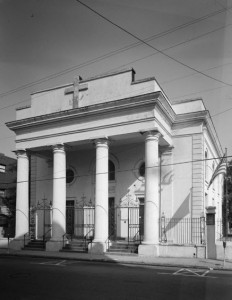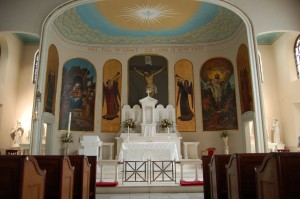Please join us for our 5:00pm ceremony.
Charleston, SC 29401-1417
(843) 722-7696
St. Mary’s Church represents the first established site of Catholicity in the Carolinas and Georgia. In 1788, the Rt. Rev. John Carroll (Prefect Apostolic of the United States) sent to Charleston the Rev. Matthew Ryan, a very pious Irish priest, who began the organization of a parish. Father Ryan remained nearly two years, but ill health obliged him to seek reassignment to Emmitsburg, Maryland. Near the end of 1789, Rev. Carroll appointed the Rev. Doctor Thomas Keating to replace Father Ryan. He permanently established the church. Father Keating named the parish St. Mary’s in honor of the Mother of Christ. Prior to this, the church was simply known as the Roman Catholic Church of Charleston. Poor health also caused Father Keating to leave for Philadelphia, where he died of yellow fever on March 7, 1793.
The parish meeting site was established by the efforts of both early priests and a congregation eager for regular church services. On August 24, 1789, the grounds and ruinous meeting house thereon situated between King and Meeting Streets on Hasell, were conveyed to the trustees of the Roman Catholic Community .The property was bought at Charleston District Sheriff Daniel Huger’s auction for 460 pounds sterling. It was in this dilapidated former Methodist building that the Charleston community of Catholics first regularly worshiped. The meeting house was soon deemed inadequate and plans were made to replace it with a more substantial brick structure. The new church opened with solemn Benediction in December of 1806, after a slow process of construction that began in 1801 .This structure was destroyed by the Charleston fire of April 28, 1838 -a cataclysmic conflagration that burned nearly two-thirds of the city. The cornerstone of the present church, built by Mr. Christopher Kane, was laid shortly thereafter on August 15, 1838. It was reopened for Divine Worship on June 9, 1839. St. Mary’s was formally consecrated on March 23, 1901, by the Rt. Rev. H.P. Northrop, Bishop of Charleston.
This Greek Revival edifice survives some of Charleston’s most notable natural and social incidents. The Civil War brought upon considerable bombardment of the Charleston peninsula in 1864. One Union shell caused the destruction of the Henry Urban organ in the rear balcony section while another damaged the left front of the church exterior. Numerous other shells obliterated gravestones and caused other minor interior damage. The church escaped three noteworthy natural disasters with only minor damage -the Charleston earthquake of 1886, the great hurricane of 1893 and Hurricane Hugo of 1989. An act of incorporation was granted by the legislature of South Carolina on February 19, 1791, forming into one body members and officers of the Roman Catholic Church of Charleston. This act was amended in December 1837, officially changing the name to St. Mary’s, though the parishioners had called the church St. Mary’s since the 1790’s. The charter was renewed March 13, 1872. On October 27, 1897 , the congregation voted to transfer the church property to the Bishop of the Diocese of Charleston, who under the laws of the State of South Carolina formed a corporation sole. A deed was duly executed and delivered to Bishop Northrop. The names of the trustees on the first deed of trust appear to have been Irish, owing to the early influx of Irish immigrants into the port of Charleston. French refugees from the West Indies greatly augmented this congregation. In 1793, the Marquis de Grasse, with 100 white passengers and 14 servants, escaped from Santa Domingo during an insurrection and came to Charleston. The Marquis de Grasse had a noteworthy role in the American Revolution, having commanded naval forces of the Marquis de LaFayette at the decisive British surrender at Yorktown on October 19, I 791. Two daughters of Admiral de Grasse were later interred in the churchyard. Other insurrections occurred in the West Indies, and ships brought more refugees, many descendants of whom currently attend St. Mary’s. By Easter, 1819, there were 200 Communicants. The registers of the church were kept in French until 1822, when newly appointed Bishop John England directed that the records were to be recorded in English. Bishop England was the seventh pastor of St. Mary’s and the first Bishop of the new diocese of Charleston.
Over the main altar hangs a painting of the Crucifixion by John S. Cogdell, painted in 1814. It was injured by the fire of 1838, and restored by the same artist, a non-Catho1ic who was both a great friend of the parish and a good friend of the noted artist and inventor Samuel F .B. Morse.. The twenty-three paintings which adorn the church were made by Caesare Porta, of Rome, Italy. They are copies of masterpieces. Included in these is a curious portrait of St. Peter, with six toes on his right foot. The large central painting of the Assumption of the Virgin was placed in the memory of Dr. James A. Corcoran by a number of priests he had taught in the Philadelphia Theological Seminary .The church has a crowded graveyard of local interest. Predominant inscriptions are written in Latin, French and English. Seventeen nationalities are represented spanning two centuries and three continents.
A restoration effort was made by the parishioners in 1896. The main altar and sanctuary were donated by Mrs. Louis Storen and Mrs. Theodore Wilbur, in memory of the parents, M r. and Mrs. George C. McNulty , erected on March 25th of that year. The Sacred Heart altar was given by the family of Henry Oliver, also in 1896. The Blessed Virgin altar was donated by Mary J. Powers, in memory of her parents, Mr. and Mrs. James Powers, in 1905. The beautiful stained glass windows portray various Biblical scenes and were donated by parishioners as inscribed on the ledge of each window. The windows are the creation of the famous Mayer Glassworks of Munich, Germany. The current church organ is a Jardine built in 1874. It has been reworked and updated to take advantage of the exceptional acoustics of the church. The organ was dedicated in May of 1980.
Today, the members of St. Mary’s Parish continue a long and proud legacy, built firmly upon the foundation of our ancestors, who were stalwart in their faith and who sacrificed so much to provide this beautiful house of worship for generations to come.
Pastors of St. Mary’s Church
Rev. Matthew Ryan, 1788.
Rev. Dr. Thomas Keating, 1789.
Rev. Simon Felix O’Gallagher, September 1, 1793.
Rev. Joseph Pierre Picot de Limolean de Cloriviere, 1815.
Rev. Benedict J. Fenwisk, S.J., 1818.
Rev. James Wallace, S.J., 1818.
Rt. Rev. John England, 1820, First Bishop of Charleston.
Rev. John McEnroe, 1822.
Rev. J. Barry, 1829.
Rev. Andrew Byrne, 1830.
Rev. Robert Browne, 1835. Died April 20, 1839
Rev. William Burke, July 1844. Died August 1846.
Dr. James Corcoran, Admin. 1839 – 1845.
Rt. Rev. P.N. Lynch, D.D., 1845, became third Bishop of Charleston.
Rev. R.S. Baker, July 3, 1847. Died January 30, 1870.
Rev. Claudian B. Northrop, 1870. Died September 21,1882.
Rev. J.J. Woolahan, 1882. Died September 5, 1890.
Rev. P.J. Wilson, admin. closing years of Fr. Woolahan’s illness.
Rev. P.L. Duffy, October 17,1887.
Rev. J.D. Budds, January 1894.
Rev. Thomas F. Hopkins, D.D., 1894. Died August 23, 1904
Rev. George A. Kraft, September 15, 1901. Died April 16, 1923
Rev. Charles DuBois Wood, 1923. Died January 2, 1944
Rev. Bernard Fleming, 1928. Died January 6, 1931.
Rev. J. W. Carmody, February 14, 1931. Died January 25, 1971.
Rev. Charles J. Molony, March 12, 1966 – August 1, 1967 Died October 24, 1972.
Rev. Thomas Duffy, Admin. August 1,1967. October 17,1968
Rev. Joseph J. Murphy, October 17, 1968 – June 13, 1975. Died August 11, 1998.
Rev. Charles H. Rowland, June 13, 1975 – June 15, 1982.
Rev. Msgr. John A. Simonin, June 15, 1982. June 5, 1999.
Rev. Msgr .Chester M. Moczydlowski, June 5, 1999 – June 28, 2001.
Rev. Msgr. Joseph R. Roth, June 28, 2001 .
References:
St. Mary’ Church by Rev. Thomas F. Hopkins, D.D.. Published in The Year Book of Charleston, 1897.
Will of Rev. G.P. Bournonviviere, proved Nov. 27, 1801, Charleston County Probate.
St. Mary’s Family Year Book, 1913-14. City Gazette, August 15, 1793.
Our Catholic Roots – Old Churches East of the Mississippi by Walter H. Maloney.
In the Beginning -St. Mary’s Church. Charleston. South Carolina 1789-1989. Researched and Edited by Florence Marie Hennessy, MA, Catholic University of America. History by Agatha Airnar Simmons. Brochure text edited & updated 1996 by W. Thomas McQueeney and in June 2001 by Msgr. Chet Moczydlowski. Special Thanks to Msgr. John A Simonin and to Mrs. Jervey D. Royall.


